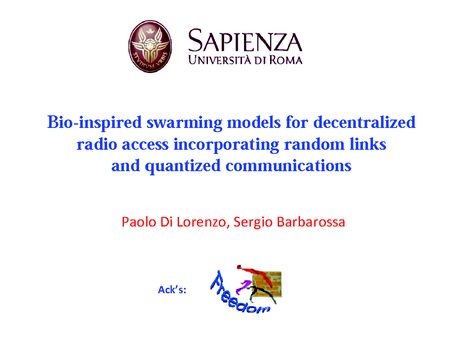BIO-INSPIRED SWARMING MODELS FOR DECENTRALIZED RADIO ACCESS INCORPORATING RANDOM LINKS AND QUANTIZED COMMUNICATIONS
Bio-inspired Information Processing and Networks
Přednášející: Paolo Di Lorenzo, Autoři: Paolo Di Lorenzo, Sergio Barbarossa, University of Rome La Sapienza, Italy
This paper proposes a distributed resource allocation strategy for cognitive radio networks based on a swarming model that incorporates random link failures and quantized communications. The swarming mechanism is used to minimize the interference produced by the cognitive users, take advantage of cooperative sensing, avoid collisions among the users and limit the spread of resources in the time-frequency domain. The mechanism assumes only local exchange of data among nearby nodes. The communications among the nodes are assumed to be affected by noise and random fading. Packet drops are taken into account as inducing a random topology, where a link is on or off depending on the decision errors. Using classical results from stochastic approximation theory, we prove that the swarm always converges in probability to a final allocation even in the presence of non ideal communications among the nodes. Numerical results show how the convergence rate of the algorithm is affected by the probability of link failures. The proposed procedure is applied to a bi-dimensional allocation in the time-frequency plane where the primary users' activity is modeled as a set of continuous-time Markov processes.
Informace o přednášce
| Nahráno: | 2011-05-24 16:15 - 16:35, Club D |
|---|---|
| Přidáno: | 15. 6. 2011 07:06 |
| Počet zhlédnutí: | 56 |
| Rozlišení videa: | 1024x576 px, 512x288 px |
| Délka videa: | 0:17:58 |
| Audio stopa: | MP3 [6.06 MB], 0:17:58 |






Komentáře